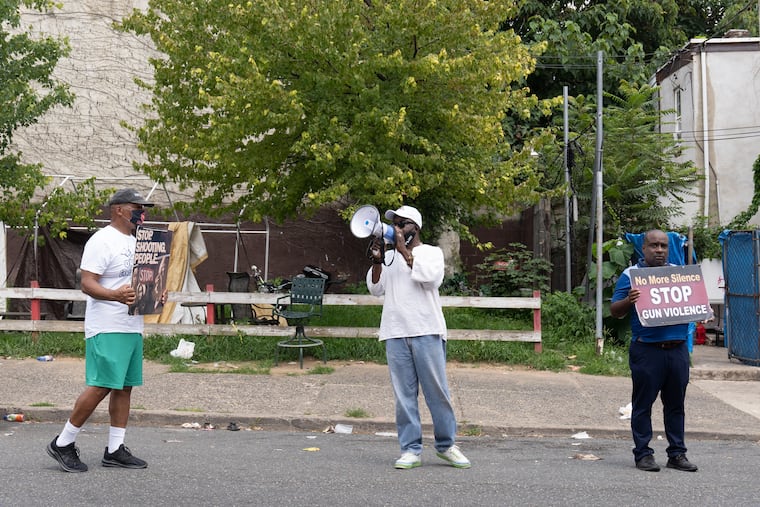In our ER, it’s more common to care for victims of gun violence than patients with heart attacks | Opinion
As two ER physicians, we have no doubt that gun violence in Philadelphia has become an emergency.

In the emergency room, actual emergencies are rare. A terrible headache, a broken bone, or sudden chest pain may represent serious health problems for our patients, but they are unfortunately routine for physicians. Certain words, however — cardiac arrest, code call, respiratory distress — heard overhead on the EMS haste system, or yelled from a patient’s room, catch our immediate attention. Those words change our mind-set and drive our actions. Our team immediately drops everything and shifts all resources to assessing and addressing the emergency.
As two ER physicians, we know that gun violence in Philadelphia has become an emergency.
A year ago, before the data were clear that shootings in Philadelphia were up, we began to feel the increase each day at work. What once were tragic singular events mainly occurring on weekend nights seemed to escalate to a nonstop torrent of lifeless bodies rushed to the ER by police or in the backseats of loved ones’ cars. Day after day, we cared for more and more victims. The truly staggering numbers continue to confirm what we felt — 316 individuals killed as of July 26, a 30% increase from 2020 to date and putting the city on track for a historic high homicide rate.
» READ MORE: Mayor Jim Kenney won’t declare a state of emergency over gun violence in Philadelphia
By now we see the acute effects of gun violence daily in the hospital. Our patients are overwhelmingly young Black men. Young once meant victims in their early 20s, but now means as young as 4 and 5 years old. They haven’t even made it to kindergarten, yet they arrive in our trauma bay. The burden of this emergency has fallen on Black individuals, families, and communities. If shooting victims survive, they may experience debilitating physical symptoms including paralysis, chronic pain, and severe mental health problems, such as PTSD. Victims’ families experience depression and anxiety. And living in a neighborhood with high violent crime rates is associated with higher rates of cardiovascular disease, greater stress during pregnancy, increased rates of preterm birth, and poor school outcomes for youth.
The wave of shooting victims also impacts our teams. In the ER and trauma bay, doctors, nurses, technicians, registration, and chaplains come together to find injuries, stop the bleeding, and save lives. At times, we are successful. But all too often, there is little we can do to overcome the brunt of trauma. We attempt to steel ourselves as we deliver gut-wrenching news to families and bear witness to emotional and mental breakdowns.
A Black woman from registration said to one of us recently: “It’s too much, I can’t take this anymore.” Another provider had to leave the ER immediately. Yet another staff member awakens at night imagining another EMS haste for a shooting. Acute stress, anxiety, PTSD, and other forms of psychological distress are common among health-care workers repeatedly exposed to traumatic events.
We need to think critically about this emergency. First, words do matter. Recognizing an emergency signifies collective acknowledgment and support for our Black communities most impacted by gun violence. This extends to the health-care teams, faith leaders, teachers, activists, and so many others who must move forward to heal and recover from this unnecessary loss of life. Acknowledging gun violence as an emergency also signals to individuals working in the systems and structures with the ability to prevent gun violence that time and resources must and will be shifted to match the acuity of the situation.
Second, investment in preventative services and mental health should be cornerstones of gun-violence prevention. This includes community resources to identify, connect, and access quality mental health care. Gun-violence mortality and morbidity must be addressed hand in hand with proactive mental health support and reactive mental health support for victims, families, and caregivers. Hospital-based violence-prevention and trauma-informed care programs are effective but need additional resources to help victims and, crucially, prevent repeated violence.
Last, our infrastructure to support the hardest-hit communities is in dire need of financial support. We must invest in communities to expand youth engagement and adult employment opportunities, create clean, green, and healthy neighborhood physical environments, and heed evidence that addressing people’s basic needs — like structural repairs to the homes of low-income owners in mostly Black Philadelphia neighborhoods — reduce crime. We also should better empower community members and organizations most impacted by gun violence to lead prevention efforts in their neighborhoods.
In our ER, it has become more common to care for victims of gun violence than patients with heart attacks. The current pace is unsustainable. The ripple effect of a single shooting is large and compounded exponentially as the numbers climb.
Gun violence is an emergency. We need those in power to say this out loud and act.
Anish K. Agarwal (@AgarwalEM) and Eugenia South (@eugenia_south) are assistant professors of emergency medicine at the University of Pennsylvania.